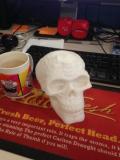Results 1 to 5 of 5
-
02-18-2014, 06:58 PM #1
Understanding Slic3r - What the settings mean and do.
The quality of a print seems to depend to a large extent on the quality of the Gcode generated by CAM software. Many of us use Slic3r with varying degrees of success, but in the excitement of printing objects, who of us has taken to time to examine the many variables that can be used to modify the output of this CAM software?
I invite you to post a short description of a variable you have applied, and an explanation of what results were achieved. For example,
Filament Diameter.
This variable is used by the software to calculate the feed rate of filament into the extruder to meet the needs of the extruder as determined by the nozzle diameter and the travel rate. It is also used to calculate the length of filament required to print the object.
The easiest result to observe is the length of filament required to print the object if this value is changed from, say. 3mm to 1.75mm.
OME
-
02-19-2014, 07:05 AM #2
OME, this is an excellent initiative, and I thank you for starting it.
Sadly, I don't know that I have much to contribute, but I'll give it a shot:
The three categories of recipes are:
Print Settings.
This set of variables deals with your gcode and how you want it executed - print speed, layer height, fill patterns/percentage, etc.
This set of variables should be constant for a particular gcode, no matter what printer or filament/nozzle you are using.
Filament Settings.
This set of variables deals with the material you are printing with - diameter, hothead temperature, hotbed temperature, cooling, etc.
This set of variables should be constant for a particular filament/print head/nozzle combination, no matter what printer or gcode you are using.
Printer Settings.
This set of variables deals with the physical attributes of your printer - bed dimensions, extruder offesets, custom positioning gcode, etc.
This set of variables should be constant for a particular printer, no matter what gcode or filament/nozzle you are using.
The benefit of having them separated is that you can change prints, but keep the recipes (if appropriate) for the filament and printer; likewise, if you move the same print to another printer, you can keep the same print and filament recipes, just changing the print variables.
I hope that was helpful.
ps - We also try to use helpful names when saving recipes. For example, a Printer recipe might be saved as "ABS_1.75_.5mm" where 1.75mm is the filament diameter and .5mm is the nozzle size, or "Clay_1.5mm" where 1.5mm is the nozzle size.Last edited by Davo; 02-20-2014 at 11:32 AM.
-
03-05-2014, 07:35 PM #3
So I had the same problems trying to understand it all, then i found the manual:
http://manual.slic3r.org/FirstPrint.html
this helped me to understand what everything meant, have a look and if there are any further Q's ask...
thanks
Pom
-
03-06-2014, 01:50 AM #4
That manual gives good definitions of what the terms mean, but doesn't go into explaining what happens when you vary to input, mainly in the pritn settings section.
Old Man Emu
-
03-07-2014, 01:26 PM #5
I've been just starting to play with these settings and will add some comments when I get things a bit better understood. However, last night, one of my work colleagues was working with his new printer and did not have the filament size set properly. It was set for 2.95mm filament, but he had 1.75mm filament. Here is the result (correct setting on the left and incorrect on the right): http://t.co/mt9YY5y04H
BiGpN4gCQAAxg1G.jpg
Pays to set the filament diameter properly!





 Reply With Quote
Reply With Quote









QIDI Slicer "Plater" is...
04-12-2024, 02:21 AM in QiDi 3D Printer Forum